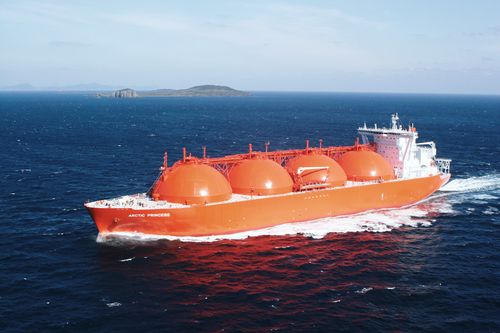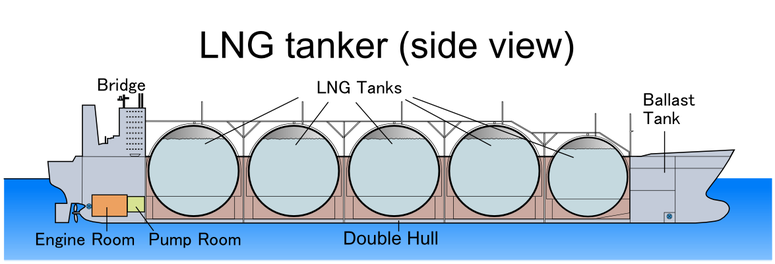Transportation of liquefied natural gas

The transportation of liquefied natural gas (LNG) refers to any movement or shipping of natural gas while in its liquid form. The two major methods of transporting LNG are by pipeline and vessel (like the ship in Figure 1, please note the enormous size of the ship).
Liquefied natural gas pipelines
Liquefied natural gas flows efficiently through pipelines so is a preferred method of transporting natural gas. Most LNG pipeline infrastructure takes the LNG between liquefaction facilities and storage facilities, from storage facilities to tankers, and from tankers to re-gasification facilities. LNG is much denser than compressed natural gas (CNG). This means that much higher amounts of gas are able to be transported for the same volume flow. The downside is that LNG pipelines are difficult and costly to construct.
As LNG requires a temperature of -160°C (-260°F) [3] to remain in its liquid form, significant insulation must be incorporated into LNG pipelines in order to maintain this low temperature and ensure no re-gasification occurs. This normally includes a combination of mechanical insulation, for example glass foam and a vacuum layer [4]. This complex insulation system makes LNG pipelines significantly more difficult and expensive to manufacture than standard natural gas pipelines.
Liquefied natural gas vessels
The majority of worldwide LNG exports take place at an intercontinental level, meaning that shipping LNG across the ocean is often required. This is done with the use of an LNG vessel or LNG ship, which transports large quantities of LNG between export and import terminals. Several types of LNG vessels exist in the industry today, with the main one being referred to as an LNG tanker, as seen in Figure 1.
Layout of an LNG tanker
The main components of an LNG tanker are the boiler and pump rooms, a double hull for added strength, bow thrusters, and the LNG storage tanks themselves [5]. Typically, an LNG tanker is built with 4 or 5 individual LNG tanks, as seen in Figure 2.

References
- ↑ Maritime Connector, "9271248 ARCTIC PRINCESS," (2007). [Online]. Available: http://maritime-connector.com/ship/arctic-princess-9271248
- ↑ http://www.vesselfinder.com/vessels/ARCTIC-PRINCESS-IMO-9271248-MMSI-257739000#ais-data-section accessed Dec 17th, 2014
- ↑ Gate Terminal, "LNG Facts," (What is LNG?), 2011. [Online]. Available: http://www.gate.nl/en/lng-facts/what-is-lng.html
- ↑ PHPK Technologies, "Choosing the right insulation," (2008). [Online]. Available: http://www.phpk.com/pdf/LNGIndustry2008.pdf
- ↑ Discovery LNG, "Shipping and Transportation," (n.d.). [Online]. Available: http://www.discoverylng.com/safety/shipping
- ↑ Tosaka, Wikimedia Commons, "LNG tanker (side view).PNG," (2008). [Online]. Available: http://commons.wikimedia.org/wiki/File:LNG_tanker_(side_view).PNG

